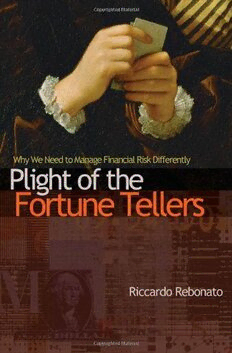
Plight of the Fortune Tellers: Why We Need to Manage Financial Risk Differently PDF
303 Pages·2007·2.022 MB·English
Most books are stored in the elastic cloud where traffic is expensive. For this reason, we have a limit on daily download.
Preview Plight of the Fortune Tellers: Why We Need to Manage Financial Risk Differently
Description:
This book was an early warning to the professional risk management teams of banks about what is predictable and to what confidence intervals events can be realistically viewed within. The hard scienced professionals within the risk management divisions of bank have developed, over the last few decades, more and more sophisticated tools to try to measure financial risks. The author believes that both data mining and distribution fitting are being over used to give a sense of false security on the stresses of a portfolio. He believes that backward looking frequentist methodologies for stress testing run into the problem of having too few examples of similar economic backdrops to make statistically significant conclusions and he believes that fitting known distributions to observable data and abstracting to what the mass under the tails is misguided for a multitute of reasons. All of these criticisms most people think go without saying, but glancing through risk literature in which authors claim that they believe with more than 99.9x% confidence that they will be able to manage some risk remind us that common sense doesnt always prevail in sophisticated institutions.
The author argues his perspective from various angles. The one which has most merit is probably the idea that paramater estimation in noisy environments makes it impossible to have high confidence in ones paramater assumptions. Sensitivities of distribution of outcomes to parameter estimates are often of large orders of magnitude in the tails of distributions. All of us who hear people describe losses as 6 sigma events that should have never happened, the very description of it as an event of exceedingly low probability which seems to happen with much higher probability than the people who claim their uniqueness, makes us believe it is almost certainly the assumed model of the world was wrong, not we were just exceedingly unlucky to have witnessed an event that happens once in the solar systems existence. The author also talks about the world and its distribution of outcomes is non-stationary, on all time scales. He describes the fact that rare events, by definition of being rare and our relevant history too short to have significant frequency estimations, cannot be fit into probability estimations with high precision.
The author also encourages risk management to delve much more deeply into subjective probability assesments. He does not believe the past will tell us the future and data mining might bring about a sense of false confidence without proper analysis of future risks. US housing is a fantastic example of this, models were all backward looking and thus probabilities of collapse were skewed based off historical stresses not being relevant to future stresses, a data set of 70 yrs would not have been sufficient to cause warning of the danger that we experienced. Sometimes over reliance on historical data as a predictor of future returns can cause bubbles in themselves by creating the illusion of riskless gains in risky markets in excess of risk free rates.
Most of the book gets to what almost all investment professionals realize. Risk isnt math, there are elements of math which help us aggregate risks, but their utility is bounded both by the data we have as well as the assumptions we make. Why do people talk about confidence intervals that are not only untestable but also nonsensical. To talk about a portfolio not being able to sustain a certain amount of loss given a time scale of human civilization really doesnt need to be argued as garbage, we all know it is, so why does it arise? Part of it is trying to bring a sense of confidence to the investors in banks at the creditor and equity level. Do the investors believe the confidence? Probably not, but it sounds like the bank is being prudent at least. This book was written and published before the financial crisis, its points, had they been internalized might have prevented the magnitude of misallocation of resources but i doubt the losses would have been avoided altogether. I think the author did a good job in articulating where risk management has been going wrong. Risk management he articulates requires better integration of those who develop the mathematical machinery and those who make investment decisions at the trading and executive level and most importantly the need for better incentive allignment of all of them with the long run of the firm. If this could be achieved, we would have come a long way.
See more
The list of books you might like
Most books are stored in the elastic cloud where traffic is expensive. For this reason, we have a limit on daily download.
